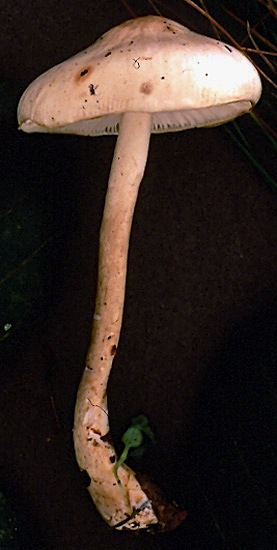
|
|
|
|
Family: Amanitaceae
|
The following is based on original research of RET: The species described here is often treated as Limacella illinita or one of its varieties in the neovolcanic zone of central Mexico. Unfortunately, most species with which this taxon could be compared are not sufficiently well-known to allow identification of this material with certainty. The glutinous cap of this species is white, with rusty tan in the center that quickly fades to white (approximately by mid-radius). Its shape is irregularly bell-shaped to broadly bell-shaped to convex; and, at times, it has a broad umbo. The cap's flesh is white. The cap's margin is nonstriate, curves inward at first and downward at maturity, splits for a short distance rather frequently, and does not extend beyond the ends of the gills. The slime layer is orangish brown to rusty tan in the youngest specimens seen and retains this color longest over the cap's umbo; in mature material, the slime is colorless or nearly so over most of the cap. The gills of this mushroom are very narrowly attached to the stem, close, white, and have unpigmented edges. The short gills are not squarely cut-off, are of diverse lengths, and occur between almost all pairs of full-length gills. The ringless stem is white, staining rusty tan (like the color of the center of the cap) where handled, is roughly cylindric, narrows upward, and has a base that is often curved rather abruptly to one side. At the bottom of the stem there are white "rootlets" binding the forest litter to the stipe base. The stem flesh is white. The colorless slime layer is present from the point of last contact with developing cap to the stem's base. Odor and taste have not been recorded for this mushroom. The spores of this entity measure (4.1–) 4.3 – 5.2 (–6.4) × (3.2–) 3.5 – 4.1 (–5.9) µm and are subglobose to broadly ellipsoid to ellipsoid, minutely spiny, almost always inamyloid, and rarely dextrinoid. Clamps are common at bases of basidia. The crippling lack of good data on species of Limacella impacts our understanding of the relationship to other macroscopically similar taxa such as L. illinita var. argillacea for which no spore measurements were included in its protolog. Among macroscopically similar unnamed limacellas, this mushroom could belong to the same taxon as L. sp-CMP0152. |






